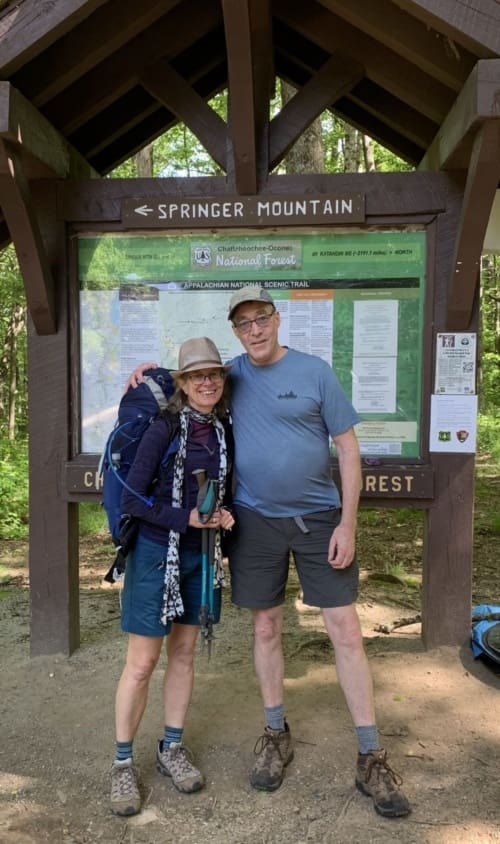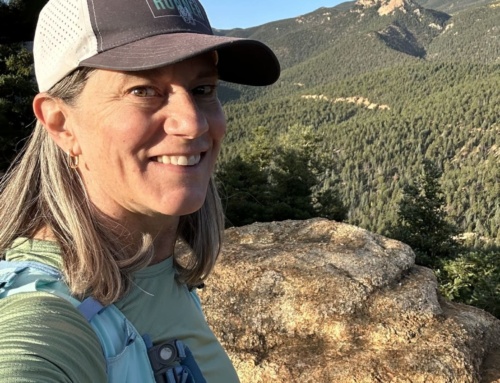
How happy (and clean!) Rick and I were at the start of a six-day backpacking trek
Which way?
After 10 miles and 9 hours of hiking, Rick and I staggered up to a signpost and a big decision: where to camp for the night.
The signpost pointed HOGPEN GAP one way, SHELTER the other.
This was our fourth day backpacking on the Appalachian Trail in North Georgia. We’d huffed up to 4,500 feet and tiptoed back down to 3,100, again and again. Pointless ups and downs, or PUDS in AT lingo. Our T-shirts and shorts were soaked with fresh sweat and stiff from yesterday’s.

Steep climbs on the Appalachian Trail in North Georgia offer occasional sweeping views of the Blue Ridge Mountains.
Which way? Rick checked the FarOut app, I unfolded a paper map.
HOGPEN GAP: point-2 miles ahead, downhill, in the direction of our endpoint, with tent sites by a highway; no picnic table and no privy, which is to say, no place to comfortably sit to eat or to do business.
SHELTER: picnic table, privy, stream, and bear cables to secure food. Yay! It was also 1.2 miles in the wrong direction, and downhill 300 feet, which we’d have to climb the next morning. Wah!
Press on or detour for comfort?
“Keep going, straight ahead, just point-two miles!” my legs screamed.
“Picnic table, privy!” Rick’s runner’s knees screamed back.
Early evening gnats jitterbugged under our hat brims, mocking our indecision.
The Appalachian Trail in North Georgia is a tunnel of merciful green shade studded with pops of Purple Skullcap, Yellow Loosestrife, and Fire Pink wildflowers and summiting to the occasional sweeping vista of the Blue Ridge mountains.

Wildflower safari! Spotting them on the Appalachian Trail kept me motivated.
Rick and I had started our 52-mile trek near Springer Mountain, the southern terminus of the nearly 2,200-mile AT. The Appalachian Trail Conservancy estimates 3 million people hike some portion of the trail every year and around 3,000 attempt to “thru-hike” the whole thing from Georgia to Maine or vice versa; only 25% complete it.
We carried supplies for six days, five nights1. Each day got a little less hard as our sea-level legs got used to climbing and our packs got lighter2. Water sources were plentiful enough that we could carry just 1.5 liters each, instead of 2.5 liters, saving 2.2 pounds, negligible sounding but noticeable feeling.
Hike, eat, sleep, repeat. Was it fun? Is backpacking fun?
Like any endurance challenge—marathon, triathlon, three hours playing Princess with a preschooler—there were long stretches of tedium, fatigue, frustration, and questioning the meaning of life. Remind me why we’re doing this?

Marathon sessions of playing princess with preschool daughter. Note the ladybug tent in the background.
“I have this theory that everything that’s interesting is mostly boring,” Elizabeth Gilbert, author of Eat, Pray, Love and Big Magic, told Max Linsky on a Longform podcast. “Life is filled with all these really interesting things, and we chase the high and the buzz of the excitement of that thing, but 90% of that thing is boring.”
Gilbert’s context was creativity, but I think it works for six-day backpacking treks, too: “If you can stick through the boring part, there’s stupendous reward just in having done that.”
Whether it’s finishing a marathon or a triathlon or an overnight trail race or sending your once-Princess-playing-preschooler off to her first-choice college, there is that sense of accomplishment and satisfaction with having achieved something hard3. Not everyone can do that. Not everyone even has the privilege to try.
Pay attention to the path, I reminded myself. Pay attention to right now, to your great good fortune.
Rick’s knees won: We hiked 1.2 miles (in the wrong direction!) to the shelter, which we had all to ourselves (hmmm, wonder why?). It was luxurious to spread gear and food4 across a picnic table. I set up my tent on a swath of comfy long grass. We refilled our water bottles at the promised cold stream.
Not that it was all rose-colored wildflowers and rainbow unicorns5. At the promised cold stream, we also dropped and broke our water filter. Oof.

Plentiful water on the Appalachian Trail lessened our backpack load.
5 Backpacking Footnotes for Runners
- What I Carried
Into a 48L Osprey Exos backpack I stuffed a 1.5-liter hydration bladder, 1.5-person tent (for me alone), sleeping bag, sleeping pad, inflatable pillow, stove, spork, tiny Swiss army knife, portable phone charger, bandaids, toilet paper, wipes, lamb’s wool to swaddle battered toes, Teaching a Stone to Talk, by Annie Dillard. Rick carried the bug spray and sunscreen. - What I Wore
Title 9 hiking shorts, Patagonia merino wool short sleeve, Oiselle sports bra, Darn Tough wool socks, Oboz hiking boots, long viscose scarf, straw fedora. I packed lightweight hiking pants, a long-sleeve tech shirt, running shorts and shirt to sleep in, and one change of sports bra, undies, socks. - How We Trained (Not)
Rick and I live at sea level in Savannah, GA. The AT in North Georgia ascends to 4,500 feet and descends to 3,100 feet over and over. We could have trained by climbing stairs or running up parking garage ramps (ugh); we could have marched around town with books in a backpack. Instead, we relied on our running fitness and were (mostly) fine, if slow and tired. - What I Ate
Breakfast: Kind bars, Justin peanut butter and honey pack, dried cranberries, black tea with two packs of sugar.
Lunch: Hard roll with salami and aged cheddar, peanut butter crackers, plus small apple or a few carrot sticks.
Dinner: Ramen noodles and jerky OR Backpacker’s Pantry freeze-dried pad thai.
Dessert: 2 ounces peach vodka.
All day: Trail mix of cashews, almonds, pecans, walnuts, dried blueberries, dried cranberries, and most importantly Justin’s dark chocolate peanut butter candy pieces.
*Snacking on trail mix all day was key to quieting hangry brain. - How We Fared
As a runner, when you’re sitting at home, the mileage doesn’t sound that hard. With 12+ hours of daylight, 8 to 10 miles sounds doable, right? Okay, now throw on a stuffed 30-pound backpack. Groan. Based on past experience, we figured we could handle six days (five nights) without refueling (or showering!). After a sweat-drenched 7 miles on the first day, we scaled back our original plan to “just” 52 miles. I imagine that every backpacking trip (or other multi-day endeavor) with a partner involves conversation and compromise. Plans and recalibrations. Cranky body parts v. single-minded determination to keep moving forward in the direction of the endpoint, that is, the car, a shower, a meal that isn’t freeze-dried, a real bed. With clean sheets! Actually, I suppose most of life is like that.






Wow, what an amazing adventure and accomplishment! I appreciate the 90% boring model–very similar to a long training run or race.
Quite an accomplishment and I enjoyed the frankness ,especially the “we relied on our running fitness” part because I always wonder when and how I would make the time to train for such a specific adventure. I chuckled at several points but my favorite was the last line of the long list of items Tish carried: “Rick carried the bug spray and sunscreen” like that was all he carried ;)
Haha, Rick had all his own gear AND the bug spray/sunscreen. Rick thanks you for pointing that out! :)
Jacki- Oh my goodness, your last line cracked me up thinking that would be funny if that was all he carried ;-)
Tish! This was so well written, as if we were there with you due to all of the detailed desciptions! I appreciated your raw honesty, helping us relate to you in the decisions and struggles. Finally, the five footnotes were fantastic. Thank you!
Great post and beautiful pictures!